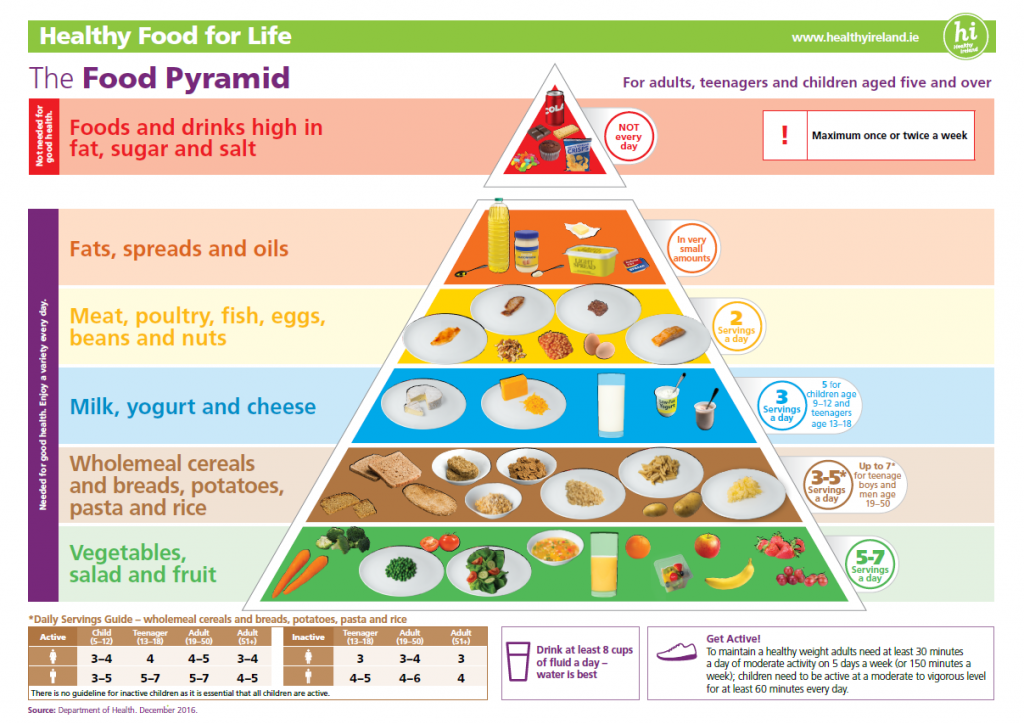How many servings of each food group should a child eat
Food groups and serving size – children
Like adults, children need to eat a variety of foods to be healthy and grow well.
Key points about food groups and serving sizes for children
- There are 4 main food groups that provide a variety of fat, carbohydrate, protein, vitamins and minerals for your child.
- Healthy eating is important for your child as they need a variety of foods to support their wellbeing, growth and development.
- The recommended serving size for each food group is different for different ages and genders.
- Eating the recommended number of serving sizes of each food group each day is the best way for your child to get all the nutrients they need.
- To prevent choking, you may need to change the size and/or texture of certain foods to make them safe for young children.
Why is healthy eating important for your child?
Your child needs to eat a variety of foods to support their wellbeing, growth and development. They are still growing and developing, so they need all the essential nutrients for them to grow healthily.
Other benefits of healthy eating for your child include:
- maintaining a healthy weight and reducing the risk of health problems such as obesity
- lowering risk of mental health conditions such as depression and anxiety
- supporting your child’s wellbeing and stabilising their mood.
Read our tips for healthy eating in children.
What are the different food groups in your child’s diet?
Provide your child with a variety of foods from these 4 food groups every day:
- vegetables and fruit
- grain foods
- legumes, nuts, seeds, fish and other seafood, eggs, poultry or red meat with fat removed
- milk and milk products.
How much is a serving?
While it’s good to choose a variety of foods, it’s also important to keep food serving sizes appropriate for your child’s body size and energy levels.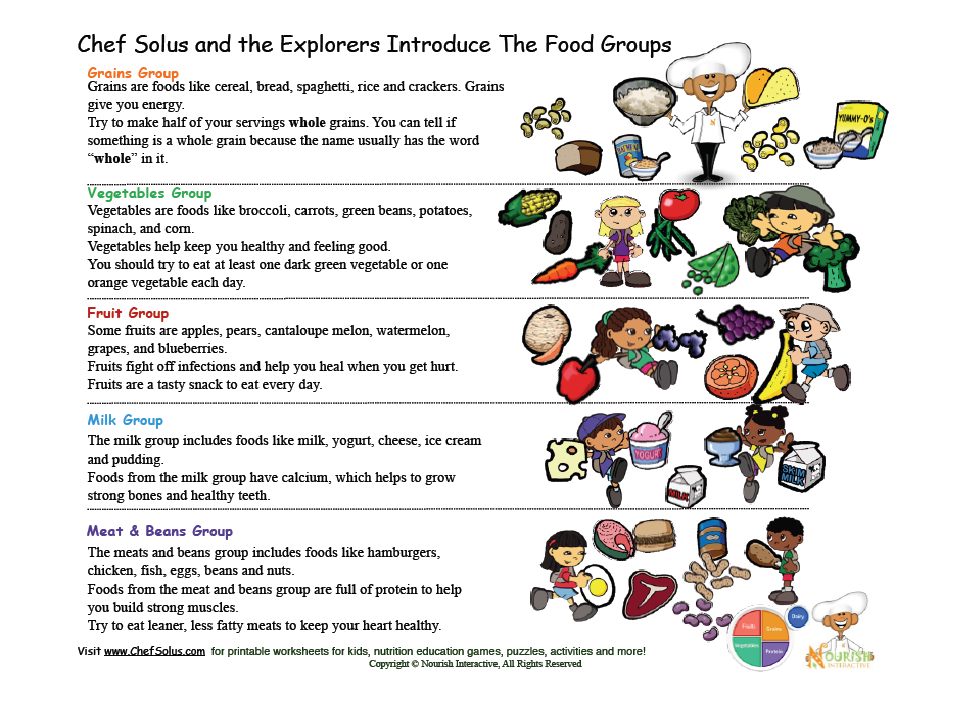 A serving or portion is a standard amount of food defined by weight. The amount your child needs can be spread out during the day as needed.
A serving or portion is a standard amount of food defined by weight. The amount your child needs can be spread out during the day as needed.
Children have smaller stomachs than adults, so they need smaller meals and snacks. Too large a serving of some foods can cause weight gain.
What is the recommended serving size for each food group for my child?
The recommended serving size for each food group is different for different ages and genders.
Vegetables and fruit
Vegetables and fruit contain fibre, carbohydrate, vitamins and minerals. They are best eaten with most meals and are a great snack option.
- Buy fruit and vegetables in season to reduce cost.
- Canned and frozen options are just as nutritious and can be cheaper options. Choose fruit canned in fruit juice rather than in syrup.
- Include a range of raw and cooked vegetables and fruit in meals and snacks.
- You get different nutrients from different coloured fruits and vegetables so try to offer a variety, eg, beetroot or plum, tomato or strawberry, broccoli or kiwifruit, carrot or orange.
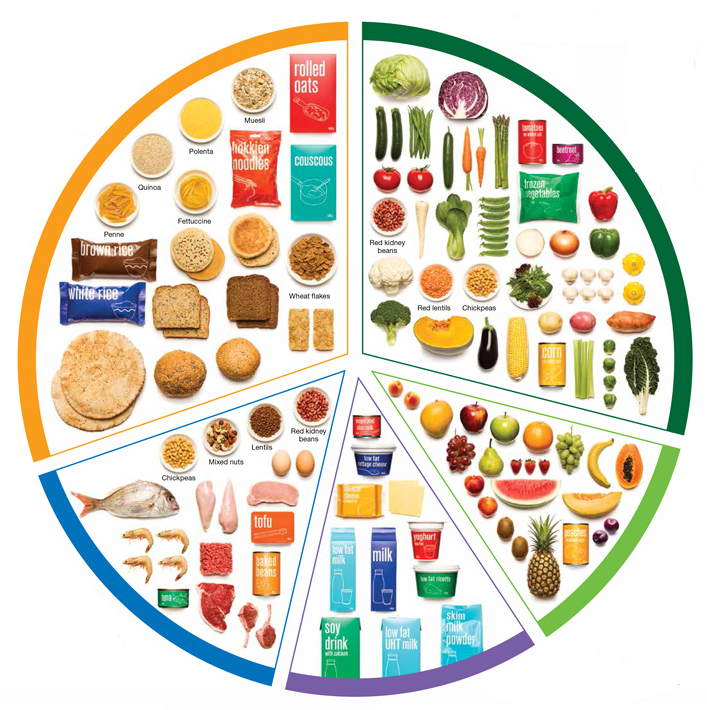
Image Credit: National Health and Medical Research Council, Australia
Image Credit: National Health and Medical Research Council, Australia
Fruit juice and dried fruit are not included in this category as they are high in sugar, which can cause problems with teeth. If you do offer these to your child, limit them to 1 serving each week and follow this guidance:
- Offer small quantities of dried fruit, eg, 3 dried apricots or 2 tablespoons of raisins (25g dried fruit).
- Dilute juice with water so it is half juice and half water.
- Offer these with other food, rather than in between meals. Cheese is a good option as it can help get the dried fruit out of teeth.
| Age group | Vegetables | Fruit |
| 1–2 year olds | 2–3 servings per day | Half serving per day |
| 2–3 year olds | At least 2. 5 servings per day 5 servings per day |
At least 1 serving per day |
| 4–8 year olds | At least 4.5 servings per day | At least 1.5 servings per day |
| 9–11 year olds | At least 5 servings per day | At least 2 servings per day |
| 12–13 year olds | At least 5.5 servings for boys and 5 servings for girls per day | At least 2 servings per day |
| 14–18 year olds | At least 5.5 servings for boys and 5 servings for girls per day | At least 2 servings per day |
Grain foods
Children should eat these foods every day since these are a high quality energy source. You should offer mostly wholegrain foods from 2 years old. Wholegrain and high fibre grains provide energy, fibre, vitamins and minerals.
- These foods include whole grain bread, whole grain cereals like oats (porridge) and whole wheat biscuits, brown rice and wholemeal pasta.
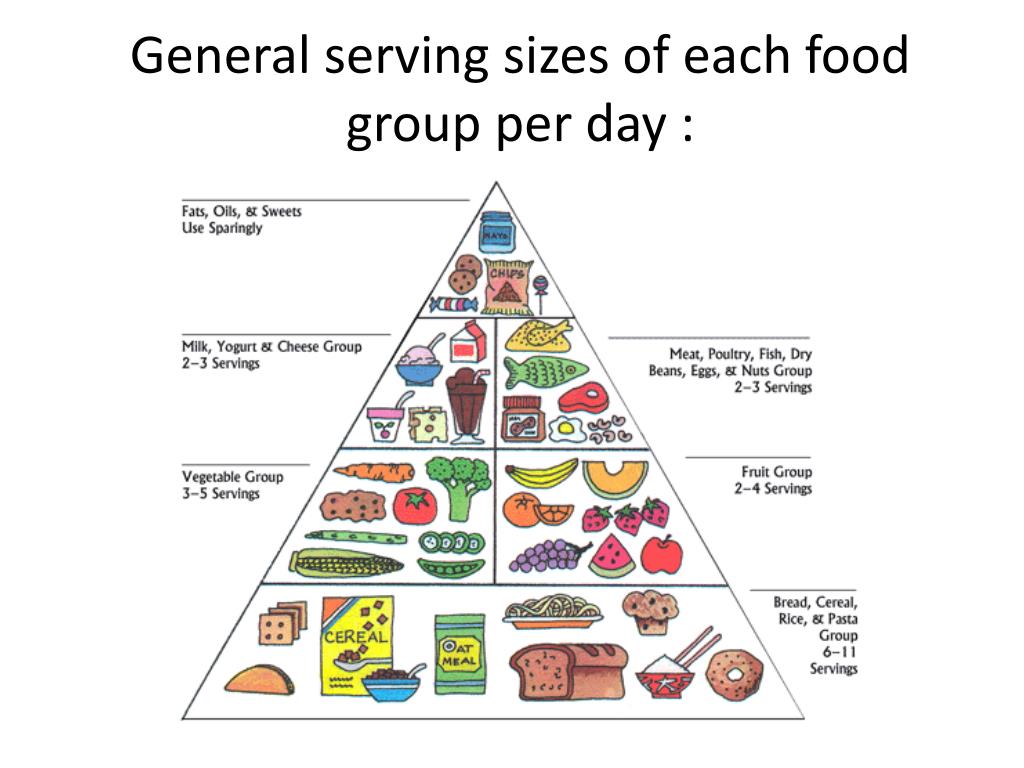
- Breads and cereals can make healthy snacks for children.
- Choose wholegrain options (eg, brown bread with whole grains, rolled oats, brown rice) as much as possible.
Image Credit: National Health and Medical Research Council, Australia
| Ages | Grain foods |
| 1–2 year olds | 4 servings per day |
| 2–3 year olds | At least 4 servings per day |
| 4–8 year olds | At least 4 servings per day |
| 9–11 year olds | At least 5 servings for boys and 4 servings for girls per day |
| 12–13 year olds | At least 6 servings for boys and 5 servings for girls per day |
| 14–18 year olds | At least 7 servings per day |
Legumes, nuts, seeds, fish and other seafood, eggs, poultry or red meat with fat removed
These foods contain protein, which is vital for children’s development.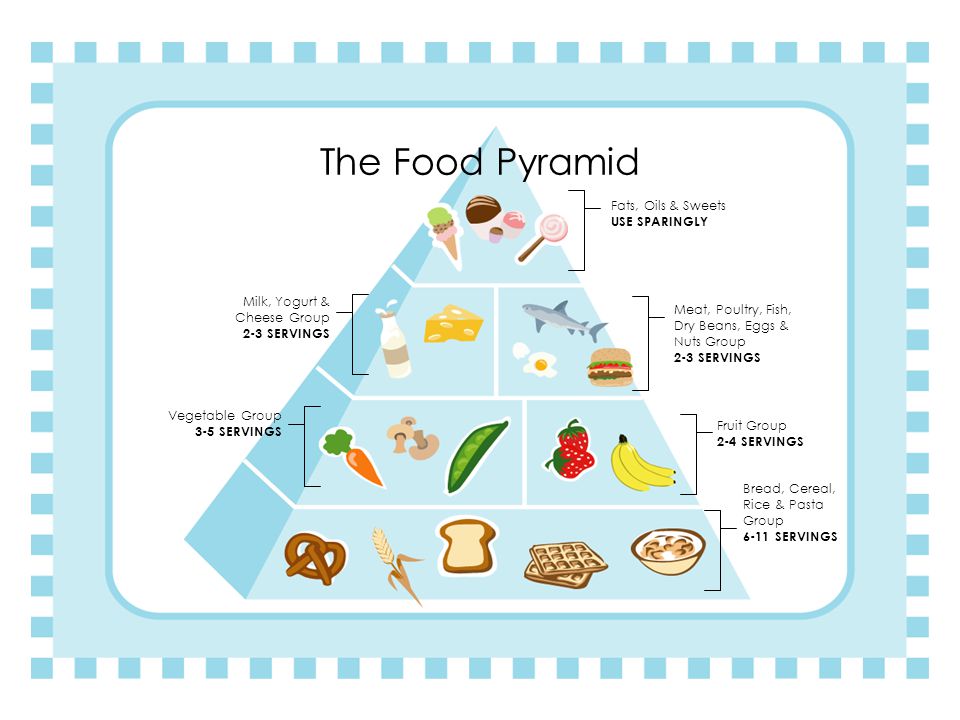 They also include fat and a range of vitamins and minerals – including iron, which is important for your blood and brain.
They also include fat and a range of vitamins and minerals – including iron, which is important for your blood and brain.
- Your body gets iron from lean meats, chicken and seafood more easily than from plants.
- To help your body take in iron, have foods high in vitamin C with meals. Try fresh fruits and vegetables, like oranges, kiwifruit, tomatoes and broccoli as these are all full of vitamin C.
- To lower fat levels, try to choose lean meat, remove bits of fat you can see on meat and chicken, and take off chicken skin after cooking.
- Children should eat some fat, but too much can cause health issues later on in life.
- Restrict processed meats, like luncheon, bacon, salami and ham, as they are often high in fat, salt and preservatives.
- Start adding lentils, chickpeas or beans to meals such as casseroles, spaghetti bolognese and curries to introduce children to these as part of a mixed meal.
Note: To reduce the risk of choking, don’t give small, hard foods such as whole nuts and large seeds until children are at least 5 years old.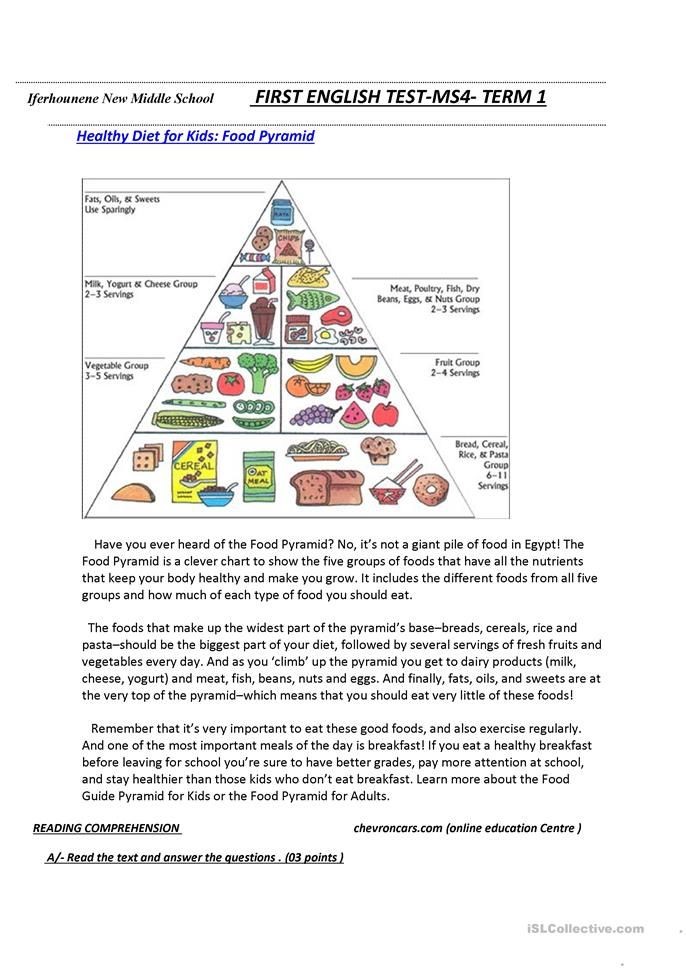
Image Credit: National Health and Medical Research Council, Australia
| Ages | Legumes, nuts, seeds, fish and other seafood, eggs, poultry or red meat with fat removed |
| 1–2 year olds | 1 serving per day |
| 2–3 year olds | At least 1 serving per day |
| 4–8 year olds | At least 1.5 servings per day |
| 9–11 year olds | At least 2.5 servings per day |
| 12–13 year olds | At least 2.5 servings per day |
| 14–18 year olds | At least 2.5 servings per day |
Milk and milk products
Milk contains energy, protein and a range of vitamins and minerals including calcium. Children and pre-schoolers need milk and milk products so they can grow healthy bones and teeth.
- When children reach 2 years old, you can begin to slowly introduce low-fat (yellow or green lid) or reduced-fat (light blue lid) milk and milk products.
- Try to encourage children who don’t drink milk to eat other milk products like yoghurt, fruit smoothies and cheese.
Limit milk to 2 cups (500ml) each day for young children. Drinking too much milk may fill them up and they may not eat enough food to get the nutrients they need.
Image Credit: National Health and Medical Research Council, Australia
| Ages | Milk and milk products |
| 1–2 year olds | 1-1.5 servings per day |
| 2–3 year olds | At least 1.5 servings per day |
| 4–8 year olds | At least 2 servings for boys and 1.5 servings for girls per day |
| 9–11 year olds | At least 2.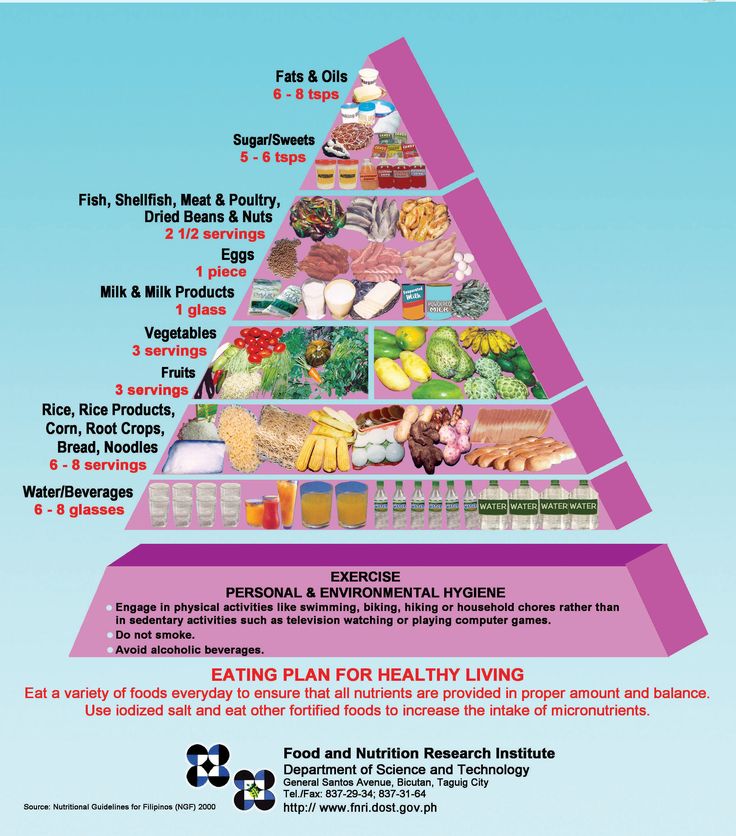 5 servings for boys and 3 servings for girls per day 5 servings for boys and 3 servings for girls per day |
| 12–13 year olds | At least 3.5 servings per day |
| 14–18 year olds | At least 3.5 servings per day |
Learn more
The following links provide further information about food groups and serving size for children. Be aware that websites from other countries may have information that differs from New Zealand recommendations.
Average recommended number of serves calculator Eat For Health, Australia
Healthy eating for babies and toddlers from birth to 2 years old Ministry of Health, NZ
Eating for healthy children aged 2 to 12 Ministry of Health, NZ
Healthy eating for young people Ministry of Health, NZ
References
- Healthy eating guidelines for New Zealand Babies and Toddlers (0-2 years old) NZ, 2021
- New serving size advice Ministry of Health, NZ 2020
- Food and nutrition guidelines for healthy children and young people aged 2 to 18 years – a background paper Ministry of Health, NZ, 2015
Reviewed by
Amanda Buhaets works as a liaison dietitian for the Auckland District Health Board.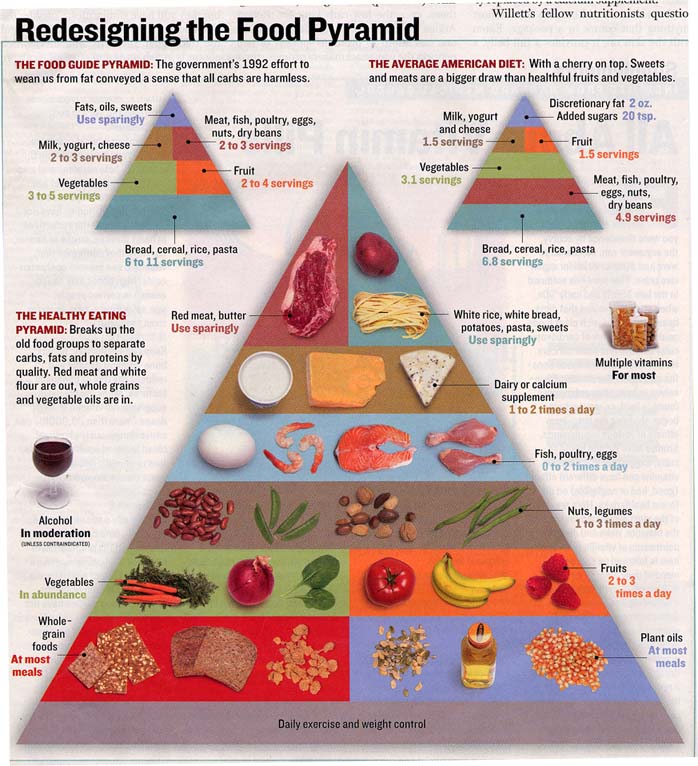 Her role includes supporting primary care and public health programmes with up-to-date nutrition information. She has a special interest in child health and supporting health professionals to have successful conversations to whānau about health and lifestyle. Her role includes supporting primary care and public health programmes with up-to-date nutrition information. She has a special interest in child health and supporting health professionals to have successful conversations to whānau about health and lifestyle. |
Food Guide Pyramid Servings for Kids | Healthy Eating
By Alicia Bodine Updated December 06, 2018
The Centers for Disease Control and Prevention (CDC) reports that healthy eating habits in childhood are essential for proper growth and development. The organization also points out that a proper diet works to prevent various health conditions. Originally, the United States Department of Agriculture (USDA) created the Food Guide Pyramid, which contained a total of six food groups. Since then, the organization has begun using MyPlate. This new dietary guideline contains five food groups, omitting the previous fats and oils category.
Vegetable Servings
The green section on MyPlate is all about vegetables.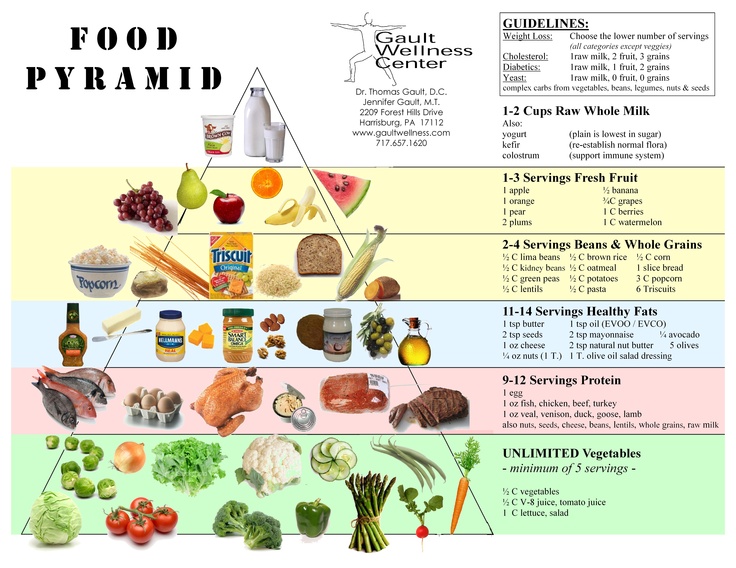 It's the largest group and is important for filling your kids with essential vitamins and minerals, as well as fiber that will keep them feeling full longer. There are dark green vegetables, like kale and broccoli, orange vegetables, like squash and carrots, and other vegetables, like corn and cauliflower. Children ages 2 and 3 should aim for 1 cup of vegetables per day, while kids from 4 to 8 need 1 1/2 cups. Girls ages 9 to 13 have a 2-cup recommendation, while boys of the same age group can enjoy 2 1/2 cups.
It's the largest group and is important for filling your kids with essential vitamins and minerals, as well as fiber that will keep them feeling full longer. There are dark green vegetables, like kale and broccoli, orange vegetables, like squash and carrots, and other vegetables, like corn and cauliflower. Children ages 2 and 3 should aim for 1 cup of vegetables per day, while kids from 4 to 8 need 1 1/2 cups. Girls ages 9 to 13 have a 2-cup recommendation, while boys of the same age group can enjoy 2 1/2 cups.
Fruit Servings
The red section on MyPlate is for fruits. This section is smaller than the vegetable section because fruits contain natural sugars. Many fruits are rich in Vitamin C, potassium, folic acid and fiber, which makes them an important part of a child's diet. Tasty options in this category include apples, berries, bananas, oranges, pears, kiwis and peaches. Toddlers ages 2 and 3 have a 1-cup recommendation for fruits, while kids from 4 to 13 need 1 1/2 cups.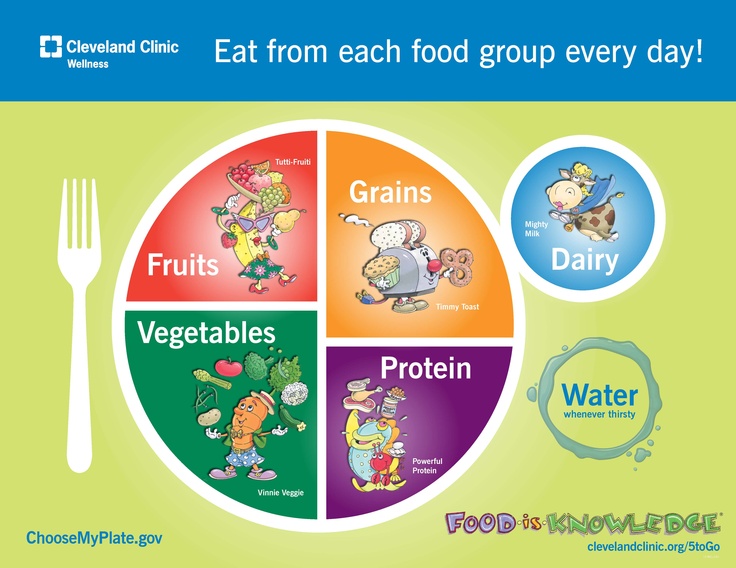
Grain Servings
The MyPlate orange section is for grains. Since not all grains are high in nutrients, parents should make sure at least half of their children's grains are whole grains. Whole grains are known to contain plenty of folate, riboflavin and essential B vitamins. Grains to consider adding to your diet include brown rice, whole wheat pasta, oatmeal and cornbread. The recommended daily servings for children ages 2 and 3 is just 3 ounces. Kids from 4 to 8 and girls ages 9 to 13 are allowed 5 ounces, while boys at 9 to 13 are permitted 6 ounces.
Protein Servings
Protein falls within the purple section on MyPlate. Your body needs protein to build and repair tissue and to make important enzymes. Foods that contain a high amount of protein include meats, beans, eggs, poultry, tofu, seeds and nuts. When choosing meats, it's best to go for the low-fat and lean options. The dietary recommendation for toddlers ages 2 and 3 is just 2 ounces, but kids ages 4 to 8 get double that at 4 ounces.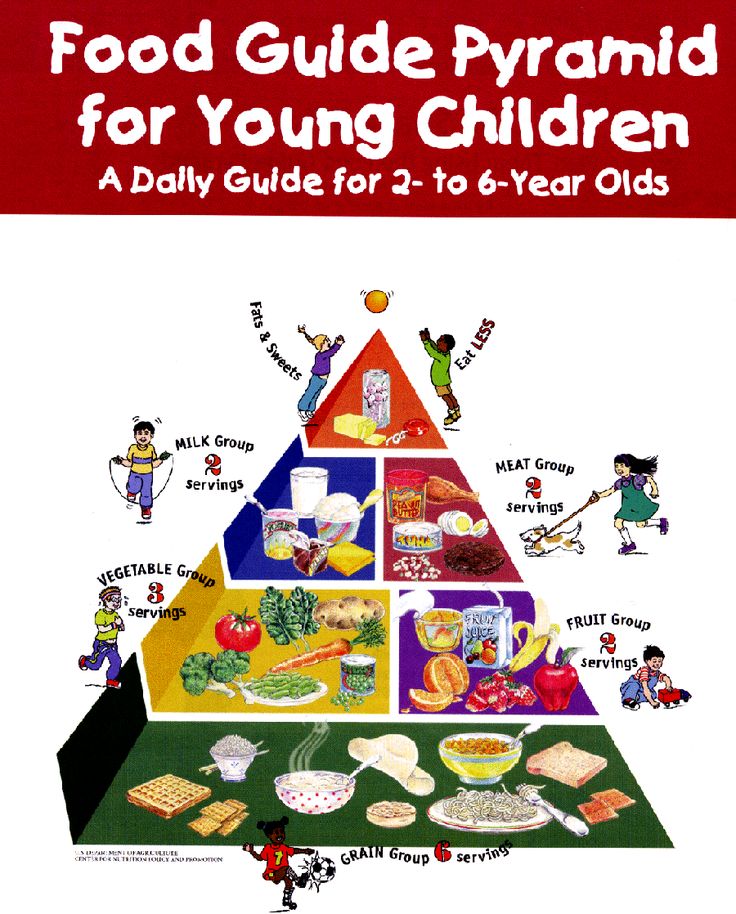 At 9 to 13 years of age, children can enjoy 5 ounces of protein.
At 9 to 13 years of age, children can enjoy 5 ounces of protein.
Dairy Servings
The blue section on MyPlate is for dairy. Dairy provides us with calcium and vitamin D, which are good for building strong bones and teeth. Low-fat and nonfat dairy products are best, so look for that on the label when buying milk, cheese, yogurt and cream. Young kids ages 2 and 3 have a 2-cup daily serving recommendation. Children from age 4 to 8 get 2 1/2-cup servings and preteens ages 9 to 13 are allowed 3 cups.
References- KidsHealth: MyPlate Food Guide
- Pediasure: The Food Pyramid for Kids
- CDC: Childhood Nutrition Facts
- Health.gov: Dietary Guidelines for Americans 2015-2020
Alicia Bodine is a New Jersey-based writer specializing in health and nutrition. With more than 13 years of experience, her work has appeared in sites like Livestrong and eHow Food & Drink. She has also served as the Healthy Foods editor at BellaOnline.
Nutrition advice and the food pyramid
Nutrition advice is based on a person's need for food energy and nutrients. When giving recommendations in the field of nutrition, Estonia also proceeds from the dietary habits and possibilities of the population. If the recommendations are followed, the growth of the body and its need for functioning on the basis of modern views are ensured and, thus, the risk of diseases caused by an unbalanced diet is reduced.
The food recommendations are divided into groups, and for each group recommendations for consumption in portions are given according to the person's daily energy requirement. This does not mean that you need to eat, for example, two servings of potatoes and one serving of fish every day - servings can be distributed over the days for one or two weeks if desired. In addition, the average energy value and serving size within each food group is also given, as well as recommendations on which foods in each group should be preferred and which should be eaten less.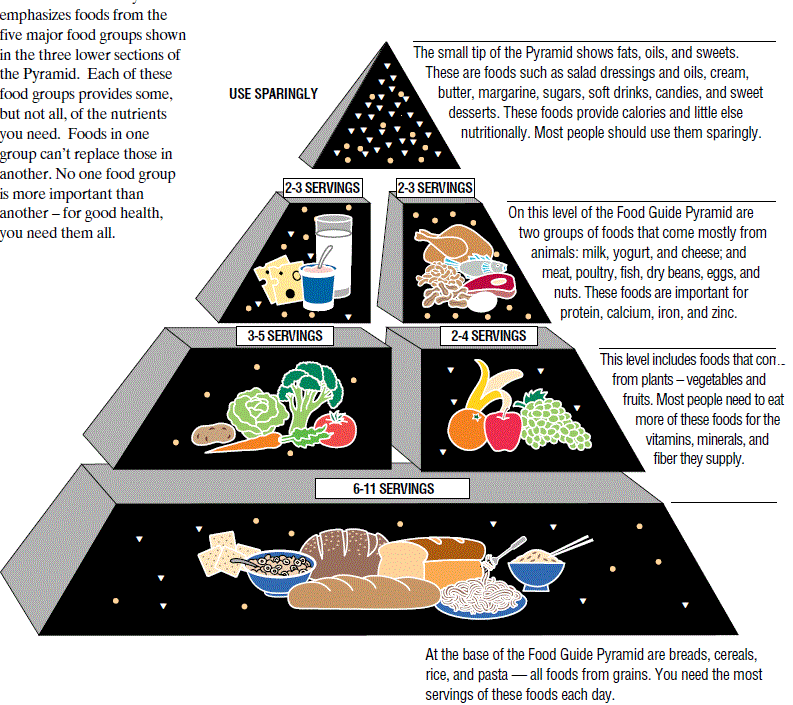 Serving sizes for food groups and within groups depend on the amount of energy in a serving of the product of the corresponding group. So, for example, one serving of vegetables contains about 30 kcal of energy, while one serving of cereals contains about 75 kcal, and a serving of dairy products contains about 110 kcal of energy.
Serving sizes for food groups and within groups depend on the amount of energy in a serving of the product of the corresponding group. So, for example, one serving of vegetables contains about 30 kcal of energy, while one serving of cereals contains about 75 kcal, and a serving of dairy products contains about 110 kcal of energy.
By eating the correct number of servings and following the recommendations for each food group, it is possible to obtain the essential nutrients, dietary fiber, vitamins and minerals in accordance with nutritional recommendations. It is possible to achieve the amount of nutrients that meets the recommendations with a different number of servings (for example, if a person cannot consume certain foods for health reasons or for other reasons), but in this case, each menu should be approached individually and, if necessary, the missing nutrients should be obtained in the form dietary supplement.
Both in terms of food safety and nutrient availability, it is important to vary in your menu the products within a food group, both by type and by producer and place of origin.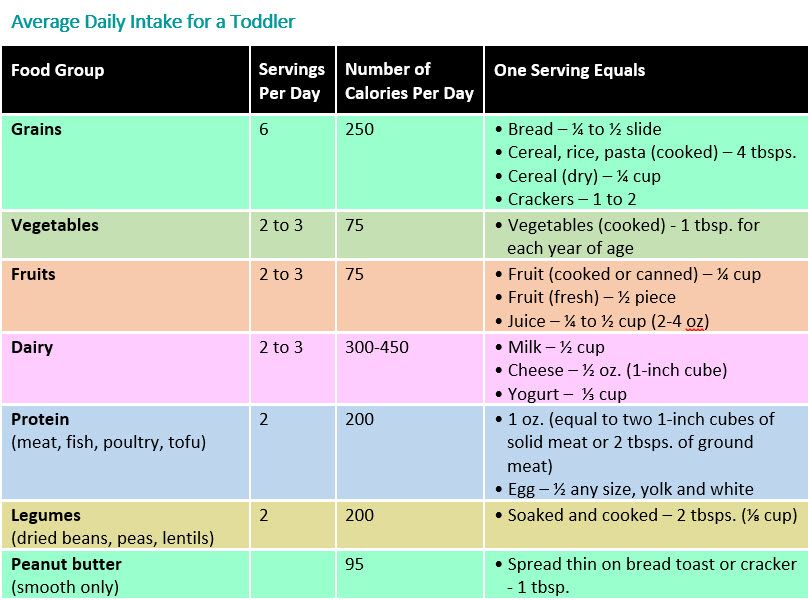 This means that people do not eat the same brand/manufacturer, the vegetables are not the same type (e.g. carrots), but try to maintain a variety of foods within the group as well.
This means that people do not eat the same brand/manufacturer, the vegetables are not the same type (e.g. carrots), but try to maintain a variety of foods within the group as well.
The Food Pyramid visualizes weekly amounts of food with a recommended energy value of around 2000 kcal for a healthy and balanced diet. The basis of the pyramid is movement, since a balance must be maintained between the consumed and expended energy. At the bottom of the pyramid are food groups that should make up the majority of our menu, and at the top are those that should be eaten in small quantities and / or rarely. At the top of the pyramid are sweets and salty snacks, which are generally optional.
Dietary recommendations divide foods into the following groups:
- Cereals and potatoes
- Vegetables, fruits and berries
- Milk and dairy products
- Fish, poultry, meat and eggs
- Added dietary fats, seeds, nuts, nuts oilseeds
- Sugars and sweets, sweet and savory snacks
In addition, there are a number of products that cannot be included in any of the groups, these include mixed dishes, soy products, sauces, soft drinks and alcoholic drinks.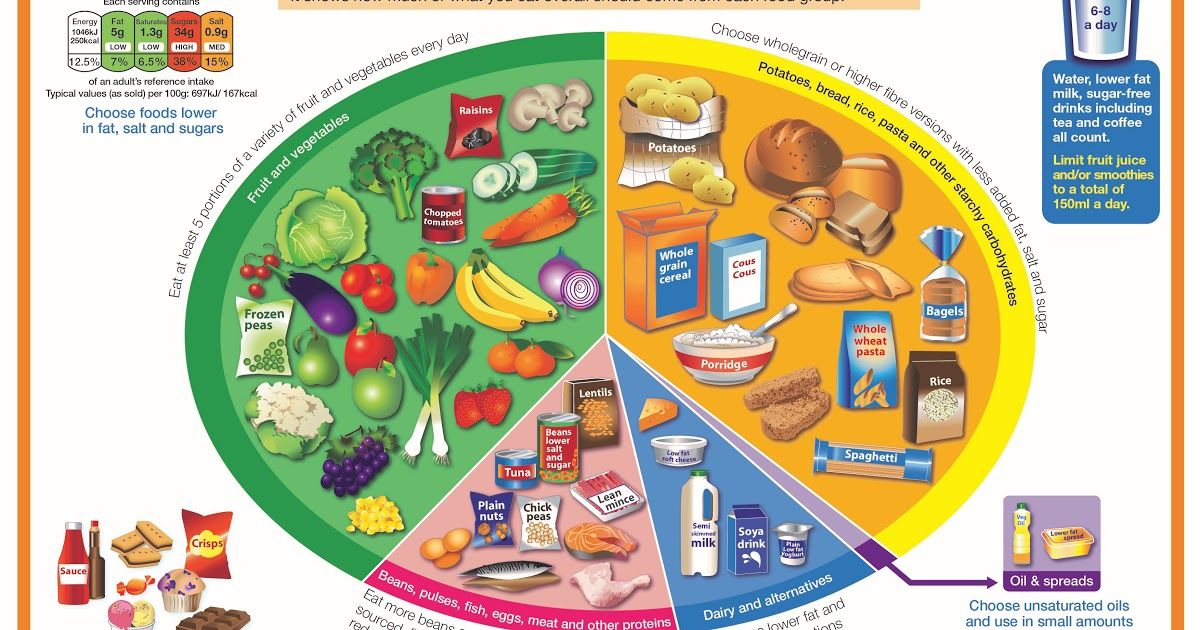 Clean drinking water should also always be available.
Clean drinking water should also always be available.
Nutrition for a child after a year - diet
It would seem that this is the variety of products that a grown-up baby's menu should abound in! So many delicious things can be cooked!.. However, by reducing breastfeeding to a minimum (as a rule, after a year it is 1 feeding per day) or by stopping breastfeeding altogether, many mothers are at a loss: what to cook, how to cook, what dishes to treat beloved baby, so that every calorie and every vitamin will benefit?
Basic rules for formulating a diet
In fact, preparing tasty and healthy children's meals is not difficult at all - recipes for the little ones do not involve many hours of standing at the stove and many processes. The main thing is to remember the basic rules for feeding children after the first year of life even at the stage of compiling the child's daily menu.
The baby's diet should be balanced. Proteins, fats, carbohydrates, minerals, vitamins - for health and proper development should be given to the child daily.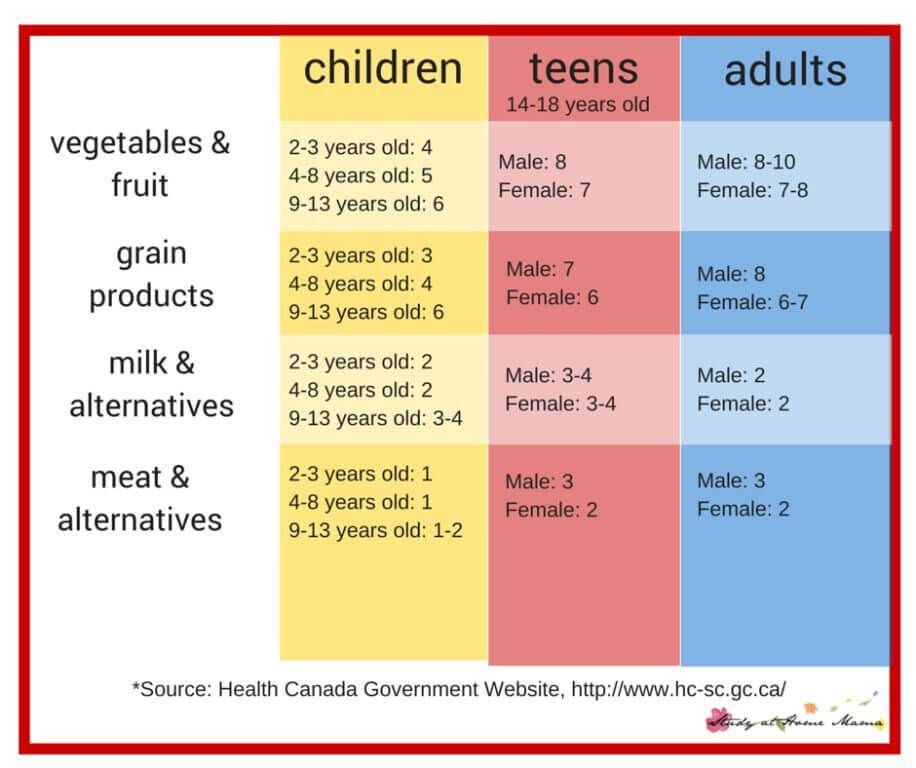 Offer crumbs dishes from vegetables, cereals, meat and fish, eggs, bread, dairy products, butter and vegetable oil, fruits. Of course, taking into account the daily norm of a product for children from 1 to 2 years. So, for example, according to the recommendations of pediatricians, babies need to get 70 grams of meat per day. And if you added meat to your lunch soup, then you shouldn’t invent another meat dish for dinner. See what your little one hasn't received today, and, guided by the rule of a balanced diet, offer for dinner, say, a cottage cheese casserole or vegetable stew.
Offer crumbs dishes from vegetables, cereals, meat and fish, eggs, bread, dairy products, butter and vegetable oil, fruits. Of course, taking into account the daily norm of a product for children from 1 to 2 years. So, for example, according to the recommendations of pediatricians, babies need to get 70 grams of meat per day. And if you added meat to your lunch soup, then you shouldn’t invent another meat dish for dinner. See what your little one hasn't received today, and, guided by the rule of a balanced diet, offer for dinner, say, a cottage cheese casserole or vegetable stew.
Consider calories and portion sizes. The physiological need for energy at this age is approximately 102 calories per 1 kilogram of a child's weight. The daily volume of food is 1200 grams up to 1.5 years and 1400 grams up to 2 years.
When cooking for a child, boil, stew, bake or steam food. But don't fry! This method of processing products is completely unsuitable for a fragile children's digestive system.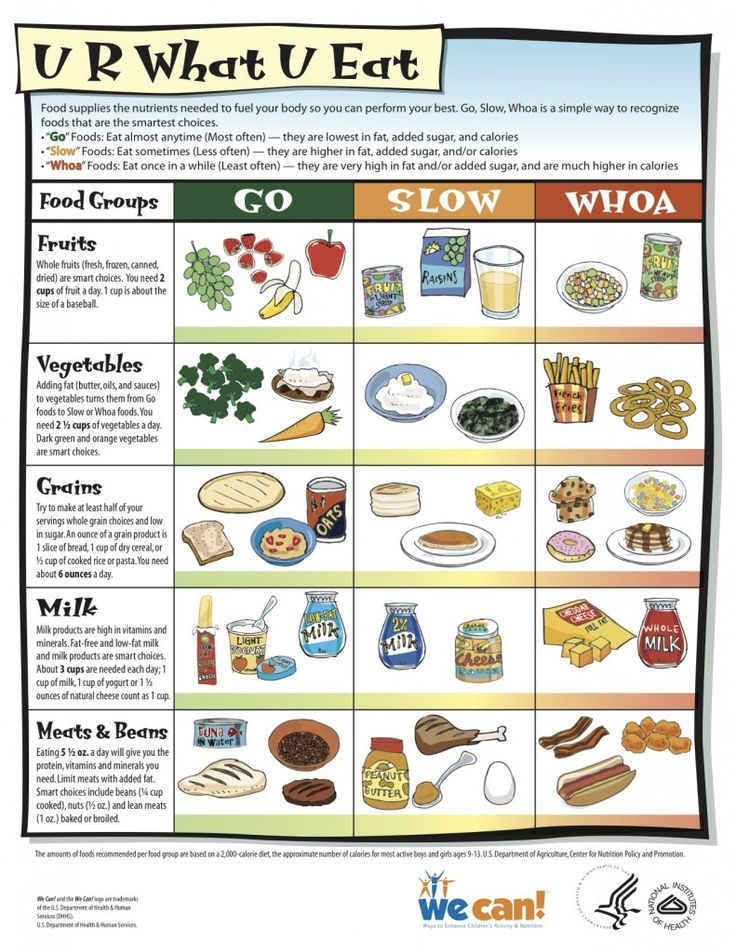
Pickles, semi-finished products, mushrooms, exotic seafood, hot spices and seasonings, fatty meats (mutton, pork) are unacceptable in the children's diet. Even as an exception, even on big holidays. What seems like a trifle to an adult, for example, a piece of smoked sausage or a salted tomato, is a risky experiment for a child's body, the consequences of which can be very negative.
Keep an eye on your water balance. A child should receive 35 milliliters of pure non-carbonated water per 1 kilogram of its own weight per day. Yes, not all kids are "water drinkers" and often refuse plain water. Replenish the norm with unsweetened compotes and herbal teas.
Limit sweets. Of course, you should not completely abandon sugar (glucose, which is so necessary for the brain). However, let it not be ice cream, chocolates, cakes and other sweets from the store. Periodically and in small portions (30-40 grams per day), offer dried fruits, fresh fruits and berries, homemade marshmallows and homemade jams.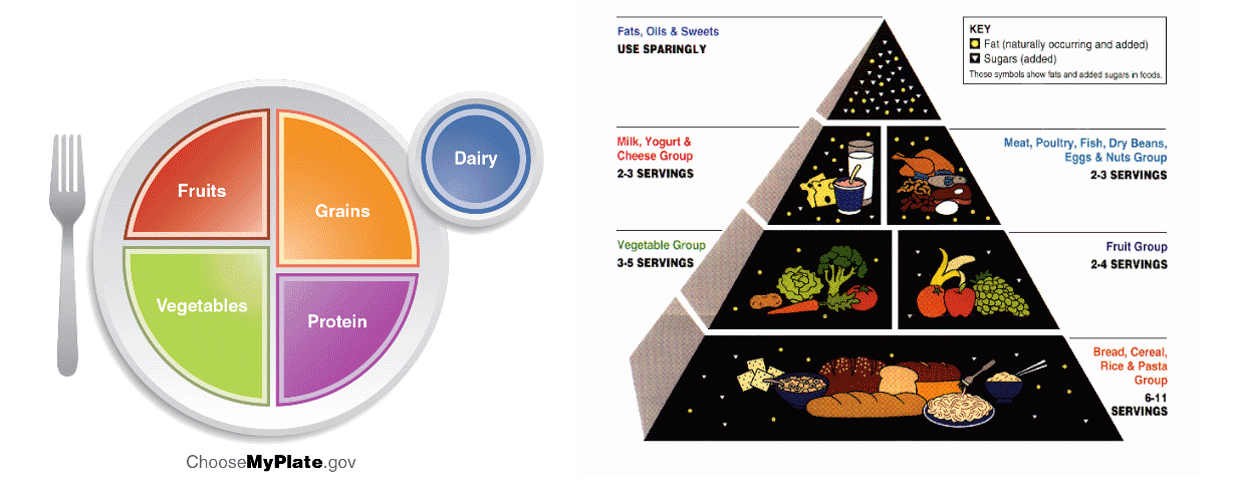
As you can see, there is nothing complicated in the above rules, or better to say, recommendations. Follow them, and, firstly, they will simplify your daily task of compiling a menu, and, secondly, they will become a kind of guarantee that your child really eats right.
Recipes for preparing food for children after a year
And now let's look at individual groups of products recommended in the diet of babies aged 1 to 2 years - the principles of their preparation, daily allowances and serving options.
Meat and offal
70 grams is the norm of meat that can and should be offered to a child every day. The best options for one-year-olds are rabbit and turkey (these are hypoallergenic and dietary meats). But by about a year and a half, veal, beef, chicken will help diversify the menu.
Meat dishes are an excellent source of mineral salts (sodium, magnesium, potassium, iron), B, PP, A vitamins and, of course, easily digestible protein, which is vital for a rapidly growing child's body.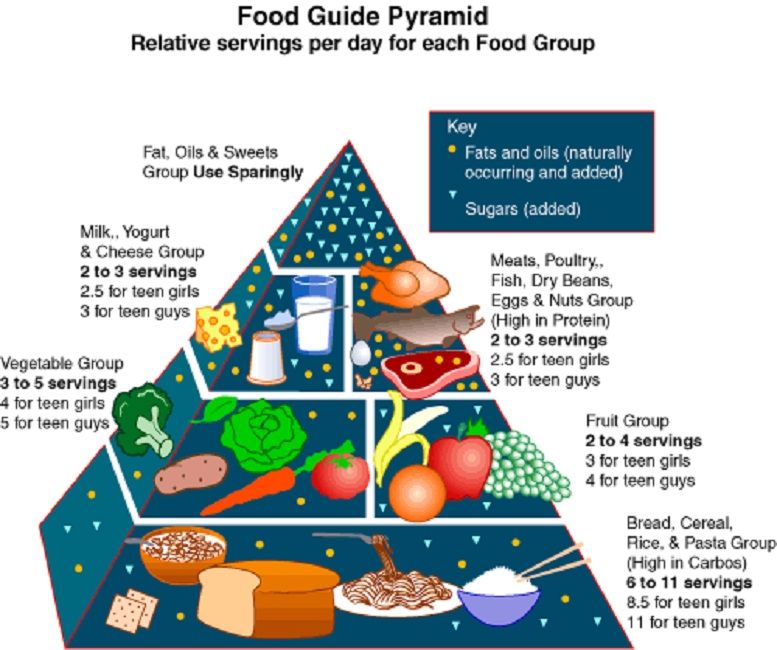
To ensure that the meat retains its nutritional value during cooking, we recommend the following:
Try to prepare dishes from fresh rather than frozen meat. If, nevertheless, pre-freezing could not be avoided, do not defrost a piece by putting it in water (with this method, the meat literally gives nutrients to the water).
To prepare boiled meat dishes, put a piece in boiling water: curdling under the influence of high temperature, the protein, as it were, “seals” all the vitamins, salts and other useful substances inside. The meat will be tasty and juicy.
To prepare the broth, put the meat in cold, unsalted water. Regarding the broth, we will stipulate that although it is allowed for use by children after 1 year, you should not part with it - this dish puts a rather serious burden on the liver. It is better not to offer the broth at all for the time being for babies who have been found to have abnormalities in the functioning of the liver and kidneys, as well as children who have frequent manifestations of allergies.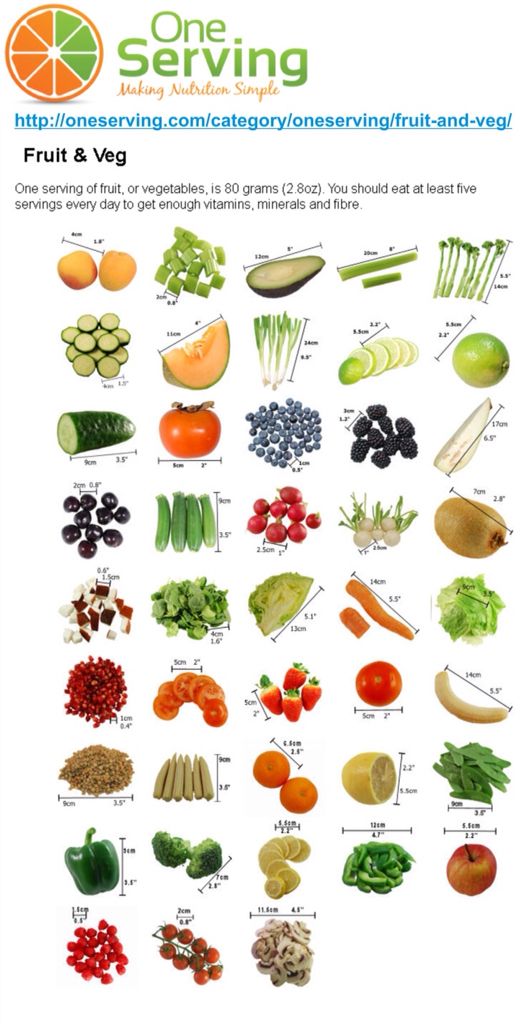 Prepare a regular vegetable soup, in which, before serving, put pre-boiled meat.
Prepare a regular vegetable soup, in which, before serving, put pre-boiled meat.
Recommended meat dishes in the diet of children from 1 to 2 years old: steam cutlets, stewed meatballs with vegetables, soup-puree with meat, steam zrazy and meatballs, steam soufflé, goulash, lazy cabbage rolls.
By-products - liver, tongue, heart - in the diet of children from 1 year old are allowed approximately 1 time per week. These are valuable protein products rich in vitamins and microelements. Offal is best digested in combination with vegetables or cereals. Delight your baby with liver pate or liver soufflé, stewed heart in sour cream sauce, boiled tongue.
Fish
The most valuable protein product, rich in fat-soluble vitamins K, E, D, A, trace elements and amino acids. The only and significant “but” of fish is a highly allergenic product. If even at the stage of feeding, you noted allergic manifestations in the child after eating fish, it should be excluded from the menu until the child reaches 2-3 years of age.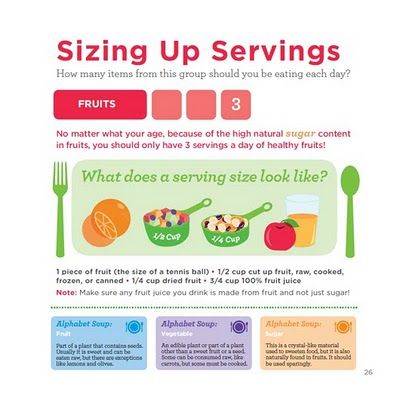 If the baby ate fish with pleasure and without any negative consequences, then after a year continue to delight the baby with dishes from white low-fat sea fish. Why marine? It's simple - it has the least bones. Choose hake, horse mackerel, pollock, cod, tuna. And closer to two years, more fatty varieties, such as mackerel, can be gradually introduced into the diet. Of course, not smoked or salted! Offer your child boiled or baked mackerel, after carefully separating the meat from the bones - it's very tasty!
If the baby ate fish with pleasure and without any negative consequences, then after a year continue to delight the baby with dishes from white low-fat sea fish. Why marine? It's simple - it has the least bones. Choose hake, horse mackerel, pollock, cod, tuna. And closer to two years, more fatty varieties, such as mackerel, can be gradually introduced into the diet. Of course, not smoked or salted! Offer your child boiled or baked mackerel, after carefully separating the meat from the bones - it's very tasty!
Fish in the children's menu should be present no more than 1-2 times a week (portion is approximately 25-30 grams). But fish broths should be refrained from up to 3 years. Canned food and caviar are forbidden foods for young children. As well as seafood.
Recommended fish dishes in the diet of children from 1 to 2 years old: vegetable soup with fish (boil the fish separately and put in the soup just before serving), fish steam soufflé, fish meatballs, boiled and baked fish, fish steam cutlets and dumplings .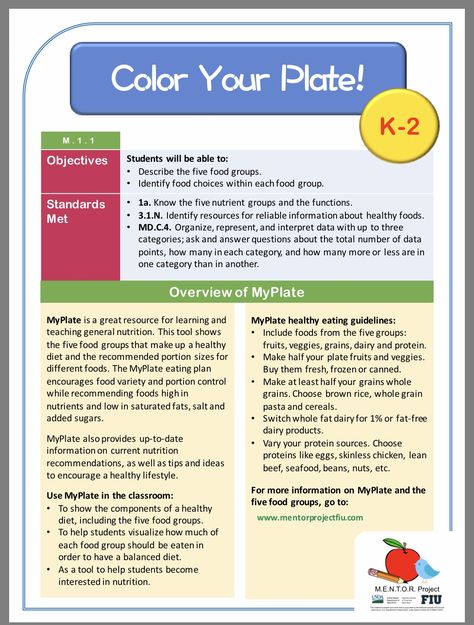
Dairy products
Dairy and fermented milk products must be present in the daily diet of children 1-2 years old. They increase the immunity of the child, improve digestion, have a positive effect on the intestinal microflora, and regulate the functioning of the gastrointestinal tract. The daily norm of products of this group is about 300-400 milliliters.
Yoghurt (special for children - not creamy, but milky) and kefir can be given to a child daily. A drunk glass of kefir or 100 grams of yogurt (yogurt with a bite of biscuits or an apple for a snack) should be considered one full meal. Also in the daily menu there may be cottage cheese (portion - 50 grams), sour cream (a teaspoon in cottage cheese or for dressing soups, salads). But mild cheese (3-5 grams per day) and fermented baked milk 2-3 times a week.
Please note that doctors do not recommend low-fat or low-fat fermented milk products for children with normal body weight. Choose kefir with a fat content of 2. 5-3.5%, sour cream with a fat content of 10%, cottage cheese - 5-9%.
5-3.5%, sour cream with a fat content of 10%, cottage cheese - 5-9%.
As far as milk is concerned, for the time being it is better to use it only for making cereals, casseroles, soufflés (in small quantities or diluted with water). Whole milk in its “pure form” is a very difficult product for a child (children under 2 years old do not yet have the necessary enzymes for its absorption, and cow's milk protein - casein - is an allergen).
Recommended dishes from dairy products in the diet of children from 1 to 2 years old: cottage cheese with sour cream, cottage cheese with dried fruits, lazy dumplings, milk soup with noodles, homemade kefir cottage cheese, milk porridge, cottage cheese casserole.
Cereals
Hearty and delicious cereals are another daily dish on the children's menu. Buckwheat, corn, oatmeal and rice have the highest nutritional value. Barley, millet, barley porridge can be included in the diet of two-year-old babies. But semolina - as it turned out, the product is undesirable on the children's table.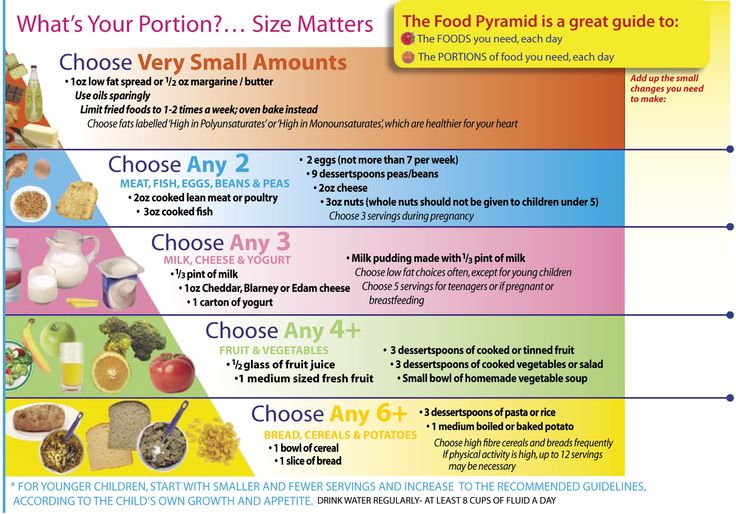 The fact is that semolina contains a large amount of gluten, which is an allergen. Of course, if your baby tried semolina, and this did not affect his health in any way, you can offer him semolina porridge no more than 1-2 times a month.
The fact is that semolina contains a large amount of gluten, which is an allergen. Of course, if your baby tried semolina, and this did not affect his health in any way, you can offer him semolina porridge no more than 1-2 times a month.
A single serving of porridge is approximately 150-200 grams, and this number of cereal dishes is enough per day. Remember, a varied diet does not involve feeding different types of cereal for breakfast, lunch, afternoon tea and dinner.
Depending on your child's reaction to milk, porridge should be prepared either with milk well diluted with water, or simply with water. A small amount of salt, sugar is allowed. Sweetened porridge is a dish on its own, for example, for breakfast. But porridge without sugar will be a great side dish. Put a small piece of butter (5-10 grams) into the finished porridge.
Ideally, porridge is prepared at one time. If you cook a large pot right away "for future use", you will inevitably have to heat the next portion before serving, and this process deprives the porridge of vitamins.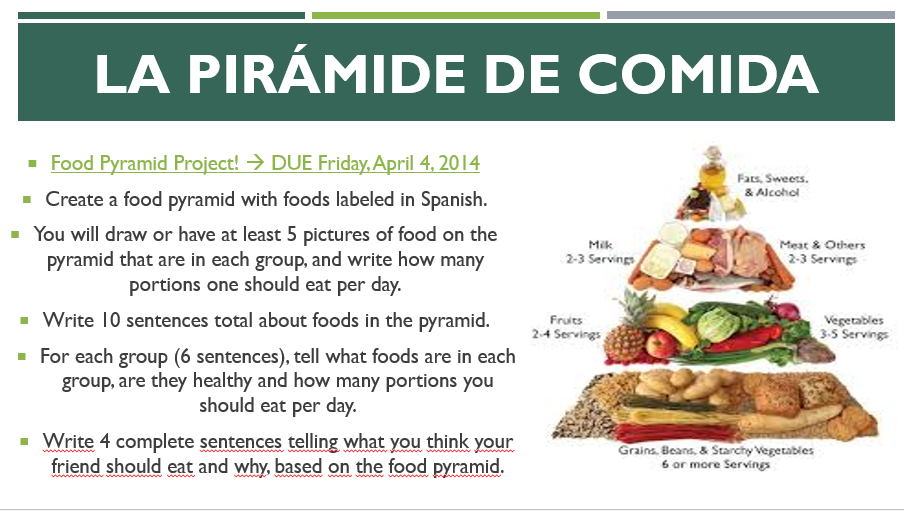
Recommended cereal dishes in the diet of children from 1 to 2 years old: rice porridge with apples, cereal soups, rice pudding, berry porridges, cereals with dried fruits, semolina-carrot soufflé, vegetable pilaf, buckwheat porridge with meat, semolina porridge with carrot juice, cereal cutlets.
Vegetables and fruits
An important source of fiber, mineral salts, vitamins, carbohydrates. Every day, treat your baby with vegetable dishes that can be boiled, stewed and baked. Prefer potatoes, carrots, cauliflower, broccoli, beets, pumpkin, onions, green peas, celery, eggplant, sweet peppers, herbs (dill, parsley) - according to the season, or use frozen ones (store or from your own summer stocks) in cooking . The recommended norm of vegetables is 250-300 grams per day.
What should I do if my child refuses to eat vegetables? First, inspire your child by your own example. It has been proven that food preferences are most often a matter of habit. If a child sees adults who eat vegetables every day with pleasure, sooner or later he will begin to imitate you. Secondly, use the interest of children in beautifully decorated dishes (if the child simply does not want to eat vegetables, then a palm tree of vegetables laid out on a plate or a boat will at least try). Thirdly, mask vegetables in multi-component dishes - soups, stews. Fourth, do not force your child to eat vegetables if he absolutely does not want to. Unpleasant emotions caused at the table can turn the baby away from this or that dish for a very long time. Fifth, remember, pediatricians don't tend to dramatize children's rejection of vegetables. The child does not want to eat vegetables? Replace them with fruit, and make sure that the whole menu is varied and balanced.
Secondly, use the interest of children in beautifully decorated dishes (if the child simply does not want to eat vegetables, then a palm tree of vegetables laid out on a plate or a boat will at least try). Thirdly, mask vegetables in multi-component dishes - soups, stews. Fourth, do not force your child to eat vegetables if he absolutely does not want to. Unpleasant emotions caused at the table can turn the baby away from this or that dish for a very long time. Fifth, remember, pediatricians don't tend to dramatize children's rejection of vegetables. The child does not want to eat vegetables? Replace them with fruit, and make sure that the whole menu is varied and balanced.
What fruits can be offered to children aged 1 to 2 years? Pears, apples, plums, bananas, peaches, apricots, kiwi - up to 200 grams per day. Do not forget about the berries: cherries, cranberries, currants, raspberries, gooseberries, blueberries, sea buckthorn, lingonberries - 20 grams per day.
Recommended vegetable dishes in the diet of children from 1 to 2 years old: vegetable soups, stews, casseroles, stewed cabbage, boiled potatoes with sour cream and herbs, salads (apple+carrot, beetroot+apple, celery+carrot), vegetarian cabbage soup , baked vegetables, vegetable puree.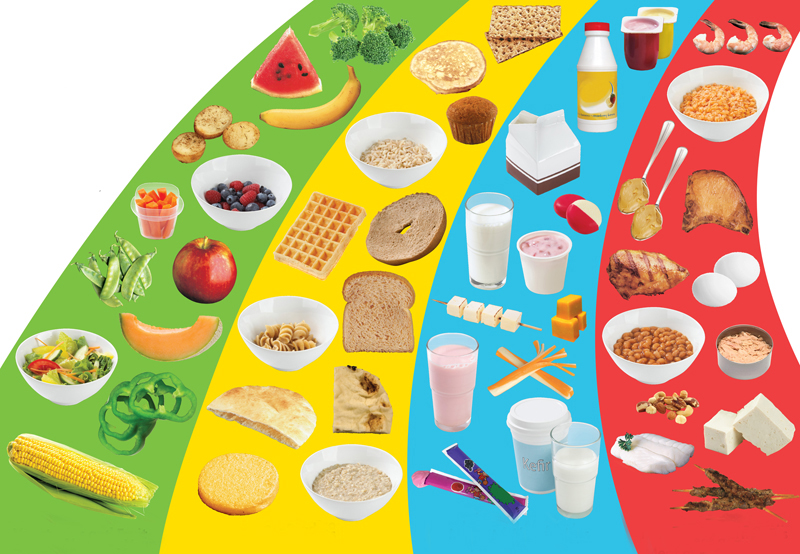
Recommended dishes from fruits and berries in the diet of children from 1 to 2 years old: fresh berries and fruits, cereals with berries and fruits, compotes and fruit drinks, jelly, baked apples, fruit purees, banana pudding.
Butter
Butter is a source of vitamin A and essential fatty acids. Some moms are wary of butter because of the cholesterol found in all animal products. However, it is important to know that if you follow the norms recommended by dietitians and pediatricians (about 15 grams per day), then cholesterol will only benefit - it is an important participant in the synthesis of hormones. Add oil to cereals, vegetable purees, vegetables when stewing, spread a thin layer on bread. Margarine, light oils and butter with additives (chocolate, honey, etc.) are not allowed in the children's diet.
Vegetable oils enrich the body with mono- and polyunsaturated fatty acids, useful for the proper functioning of the nervous system. The daily norm of vegetable oil is approximately 5-7 grams.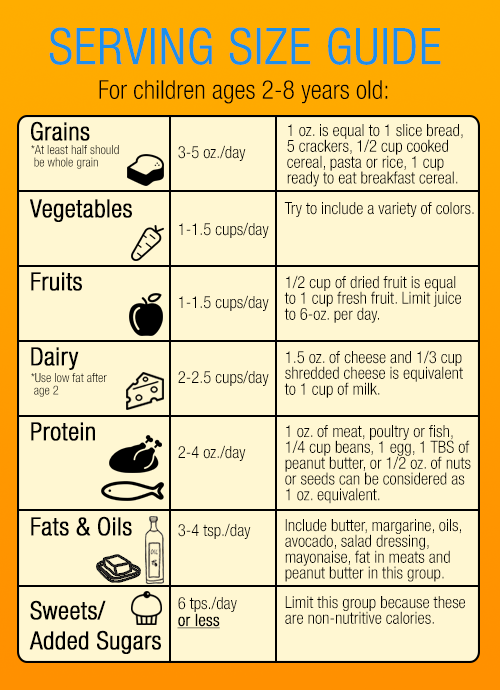 This amount of oil is sufficient for dressing salads, preparing sauces (for example, herb sauce with vegetable oil), adding to soups or vegetable main courses. Choose sunflower, olive, corn oil. Refined, that is, it has undergone special cleaning and does not cause allergic reactions.
This amount of oil is sufficient for dressing salads, preparing sauces (for example, herb sauce with vegetable oil), adding to soups or vegetable main courses. Choose sunflower, olive, corn oil. Refined, that is, it has undergone special cleaning and does not cause allergic reactions.
Eggs
Chicken and quail eggs, a healthy and nutritious product, should be regularly present on the children's table. However, no more than 2-3 times a week and provided that the child does not have their food intolerance.
How should eggs be served? Exceptionally well-cooked, that is, hard-boiled, in the form of an omelette (steamed or in the oven), as part of dishes that undergo high-quality heat treatment (soufflé, casseroles). Fried and soft-boiled eggs are dangerous foods because they can cause salmonellosis.
Cereal products and pasta
Many kids just love bread, and good luck! Bread, consisting of 70% carbohydrates, gives the body energy and is a source of B vitamins.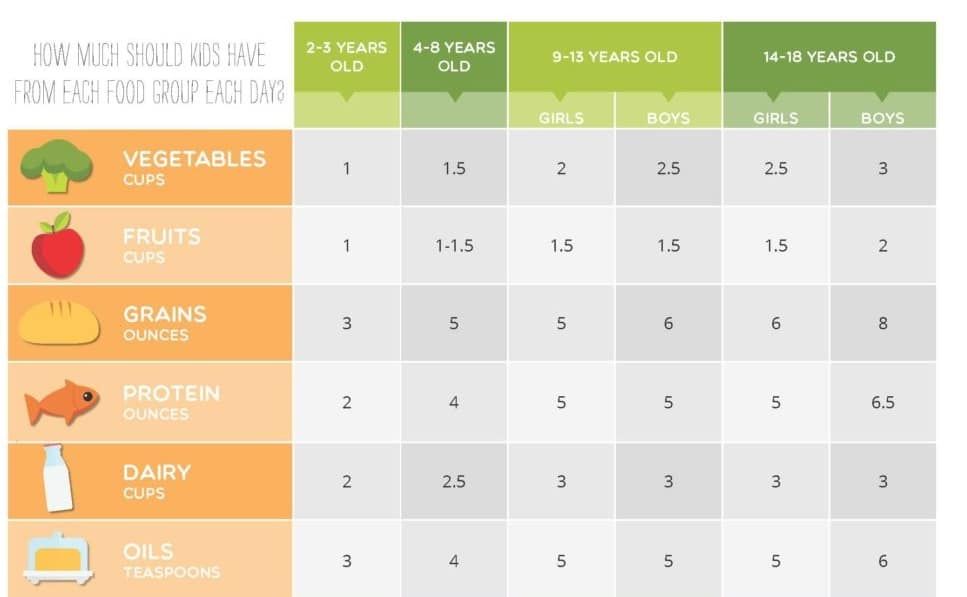 90 grams of bread or crackers (cooked at home in the oven) is the daily norm for children under 2 years old. Please note that at this age, wheat bread made from premium flour is recommended for children. Rye bread and wholemeal bread should be given only after the child reaches 3 years of age.
90 grams of bread or crackers (cooked at home in the oven) is the daily norm for children under 2 years old. Please note that at this age, wheat bread made from premium flour is recommended for children. Rye bread and wholemeal bread should be given only after the child reaches 3 years of age.
Pasta is another baby favorite. But because of the high calorie content, you should not abuse it. 50 grams a day 2-3 times a week is the norm recommended by nutritionists. Choose pasta made from durum wheat - vermicelli, noodles (small in size, convenient for the baby).
When it comes to cooking, al dente (ready but not overcooked, firm enough) is not suitable for small children. Pasta in children's dishes should be soft.
Recommended pasta dishes in the diet of children from 1 to 2 years old: milk noodles, vermicelli soup, navy pasta, pasta with vegetables.
Salt and spices
Salt and spices make dishes richer, tastier. But in baby food with them you need to be very careful.